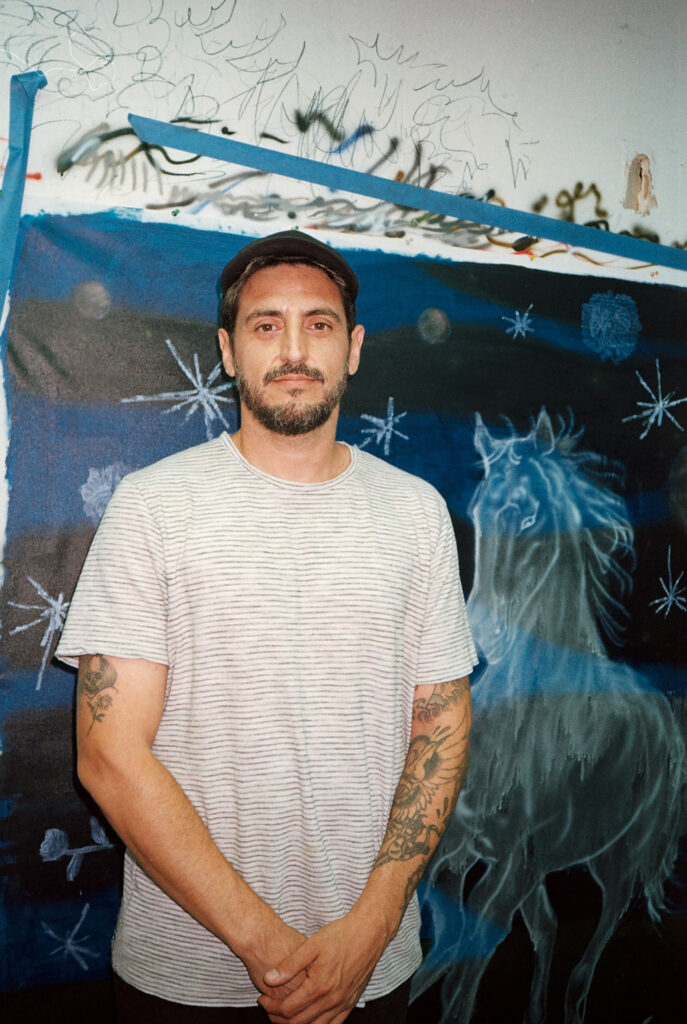Interview by Shelley Holcomb
Rooted in the sprawling landscapes of the San Fernando Valley, Javier Ramirez paints a vivid narrative of his experiences as a first-generation Mexican American growing up in Los Angeles. His signature drips and swipes of the airbrush create a delicate balance between faded memories and neglected histories, drawing inspiration from his upbringing, a blend of cultural influences specific to his community and the melting pot that is the Valley. Ramirez invites us to peer through the intricate layers of his canvases and sculptures, revealing the untold stories that linger in the margins of our everyday lives; every stroke becomes a tribute, every sculpture a bridge between worlds.
His recent solo presentation at Frieze Focus with Sow & Tailor serves as a testament to the convergence of Japanese and Latino histories, shedding light on the unsung heroes of suburban Los Angeles—the jardineros. Javier Ramirez incorporates sculptures that emulate garden ornaments often seen in suburban yards, fusing Japanese and Latino aesthetics to narrate the shared histories and cultural exchanges influencing landscaping and the labor involved. In a city often defined by its icons, Ramirez invites us to cherish the stories of those who nurture its landscapes. Through these new works, Javier Ramirez emerges as a poignant storyteller, unraveling the intricacies of cultural crossroads and captivating viewers with the city’s immigrant heartbeat.
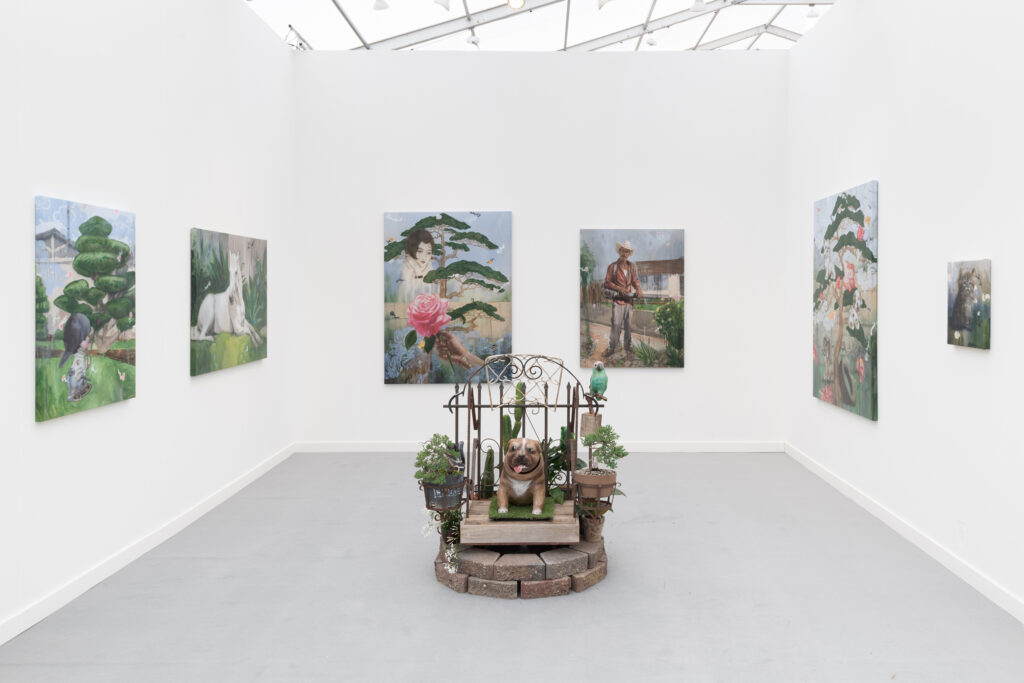
Okay, so could you give a quick blurb about who you are and what you’re thinking about right now just as an artist?
A lot of my work involves or depicts scenes from the San Fernando Valley, where I grew up. And, to me, it’s just kind of always been the backdrop to everything I’ve ever done. I’ve lived here my whole life, so it’s also a big part of my practice and my identity as a person from Los Angeles.
Your recent solo presentation at Frieze Focus delves into the shared history of Angeleno immigrant life, particularly the influence of Japanese and Latino communities, specifically the Jardineros. Can you share the personal experiences or moments that inspired you to explore this theme in your art? Because it is kind of a new thing, I feel like you’ve never focused on that.
Yeah. For sure. I guess it all kind of comes from my personal backstory. When I was a kid, like three or four years old, my mom had this work friend who was a Japanese woman, and when I first met her, this woman told me she was my Japanese grandmother. So, from then on, I believed it for a little bit, I actually thought she was my grandmother. And so from that point on, I’ve always been interested, or I always look for Japanese things in art or food or whatever, and that’s where it originally comes from. But later on in life, like ten years ago, I started practicing bonsai and learning about the history of bonsai in Japan and its connection to Los Angeles in particular. A lot of bonsai people came to Southern California, it was used to bridge the gaps between Japan and America and share this culture. So, I studied that, and the more I started thinking about my own experiences and, I guess, my relationship to gardening and what the people from my background do nowadays, the more I wanted to combine the two into a visual language. That made sense to me.
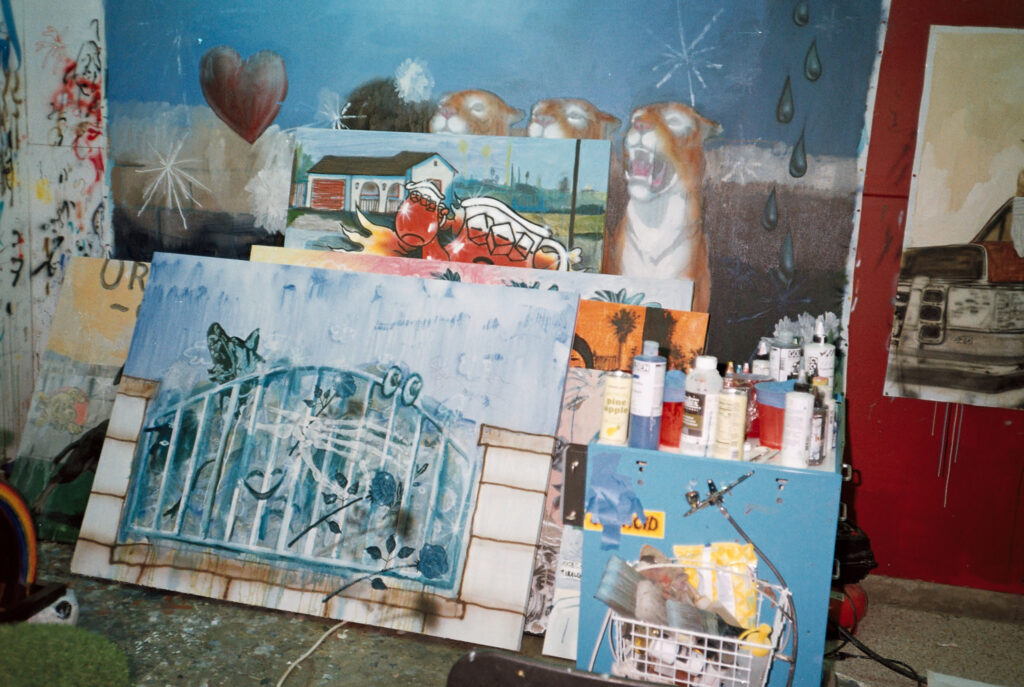
The work is centering on the significance of how the Jardineros, the Latino suburban gardeners, which I’m assuming not everybody knows that it’s like a thing. like if we’re talking on an international scale or, you know, unless you live in Southern California, you really don’t know about it. How do you capture the essence of their labor and its impact on Los Angeles? And even more specifically, the culture of the valley. What specific aspects of their contributions do you hope your viewers will recognize and appreciate?
For the reference images for the paintings, I really wanted them to be something that was real, you know, so a lot of the imagery that I use was, was photographs that I took of people I met, people that I talked to, that work on my street or that I’ve stumbled upon, like just walking my dogs. I wanted it to be a reflection of the people I see in my neighborhood. And how it’s a kind of overlooked and in a lot of senses that you never really see them except for certain times of the day. You know, but everyone’s yards are looking immaculate all the time. It’s like it’s just something that people don’t think about. And also the idea that it’s not considered an art form, it’s thought of more as labor, but it’s the opposite in Japan, you know, so that’s kind of what I wanted to mix. It’s all beautiful, it’s all art, and it deserves to be recognized, you know.
Moving along to speak about the sculptures that we saw at your solo booth at Frieze, but also, I feel like you’ve been doing these types of sculptures for a minute, like little mini sculptures that we see in a gallery setting, but they could also live in your bush, they’re lawn ornaments, you know? To take it further, I’d like to speak about how these sculptures blend together elements from Japanese and Latino aesthetics. Can you elaborate on how these sculptures serve as a visual representation of their shared histories, this history you’re talking about between the two cultures? Particularly in the context of suburban gardening or lawn features like these.
I’m thinking a lot about the way people design suburban lawns, like how they are utilizing these different types of landscaping. A lot of those philosophies come from Japanese gardening, and people don’t really notice or know. And I pick up on the little things that people often take for granted in their surroundings. Like the little old lady that sets up all the figurines on her lawn, you know, I love seeing that stuff. but I also like to link them in my own way. I’m trying to create my own language For example, the animals in a Japanese garden have a meaning; they are guardians, and there’s an overlapping of this with Mesoamerican culture as well as in Catholicism, like shrines and stuff. So I’m just trying to kind of mix it all up together and make sense of my own experience creating my own language, you know. I’m painting and making the things that I find interesting and that have been important to me in my life. Really, it’s not something I try super hard to do, but it definitely does influence my art practice. For example, when people have bonsai shows, there are very specific rules and laws about which trees go at which level and how big the pot has to be compared to the tree. And I don’t have those rules per se, but it is something that sneaks into my mind. Like when I’m making all the arrangements or figuring out which pedestal I’m going to put this little sculpture guy on. but yeah, it also just comes naturally. I don’t really try to think about it too much.
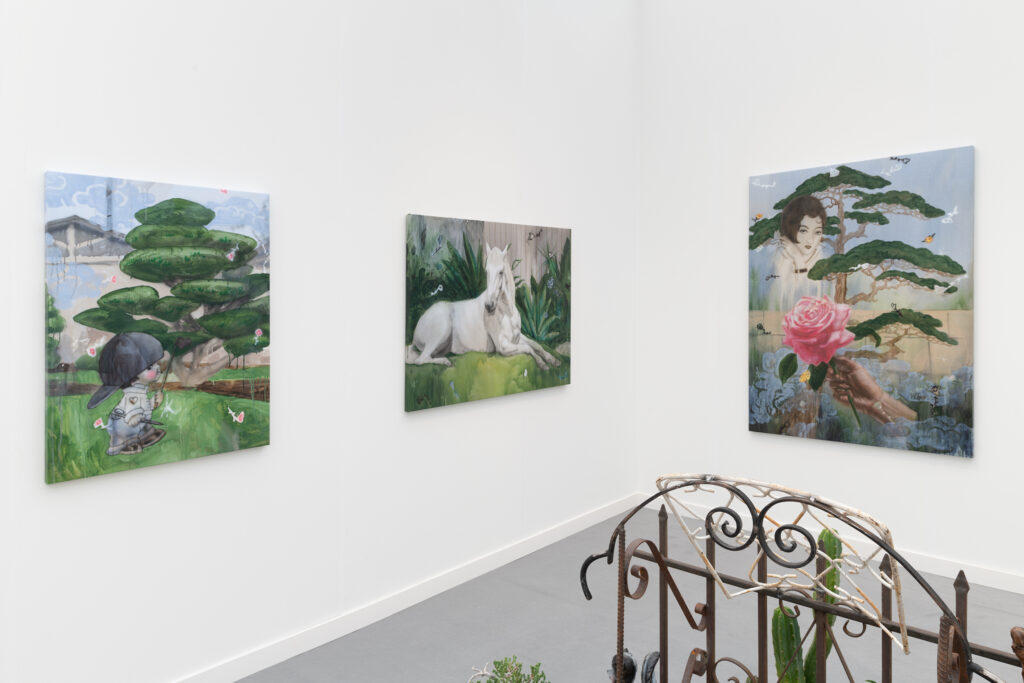
Well, I was going to say, a lot of the feeling I get from the paintings and the bonsai trees and the arrangements is this idea of care or, like TLC, both care for your own space, but also for the enjoyment of others. Just like the act of placing these lawn ornaments on display and how it conveys how one might express how they care.
Yeah. That’s really what drives my interest right now, and that’s just my reality. Right now I have 3 dogs, 3 cats, and some chickens and on top of that my Bonsai. Taking care of bonsai is a daily thing, really it is more similar to caring for a pet than plant. I guess you could say my routine, life and art practice revolve around the care of my pets and trees. that’s just my reality, you know?
One thing you were talking about also in regards to what your reality is is that you take the reference photos, which came from people in your neighborhood. A thought that came to my mind was that these subjects could be very stereotypical. Right. And so your decision to resist categorizations like being a “Chicano” or “Latinx” artist or even in the language that you’re using to describe these paintings is notable. And, so, when telling the stories of these people that you’re photographing and including in your paintings and within your own story, how do you hope your story resonates? I guess, as a first-generation Mexican American within that community, but also outside of that community. And what do you think the significance is of exploring that space?
That’s a really good question because, in my mind, I don’t feel like I’m trying not to do that. You know, it’s not something I’m actively trying to do. I guess it just comes down to the same thing. This is just my experience. I grew up super Mexican, I learned to speak English from Sesame Street, but I also grew up in a part of LA where it’s very densely populated and super diverse. I was exposed to all kinds of different cultures and demographics. It’s not something I’ve ever been like, oh, no, I don’t consider myself Chicano because I do, and a lot of that imagery really does resonate with me because I kind of did grow up like that, you know, like I was in a lowrider bicycle crew, and like, I went to, lowrider super shows and quinceañeras, ate menudo on Sunday, all that, you know, But also the way I grew up and my interests kind of like, led me to different things as well.
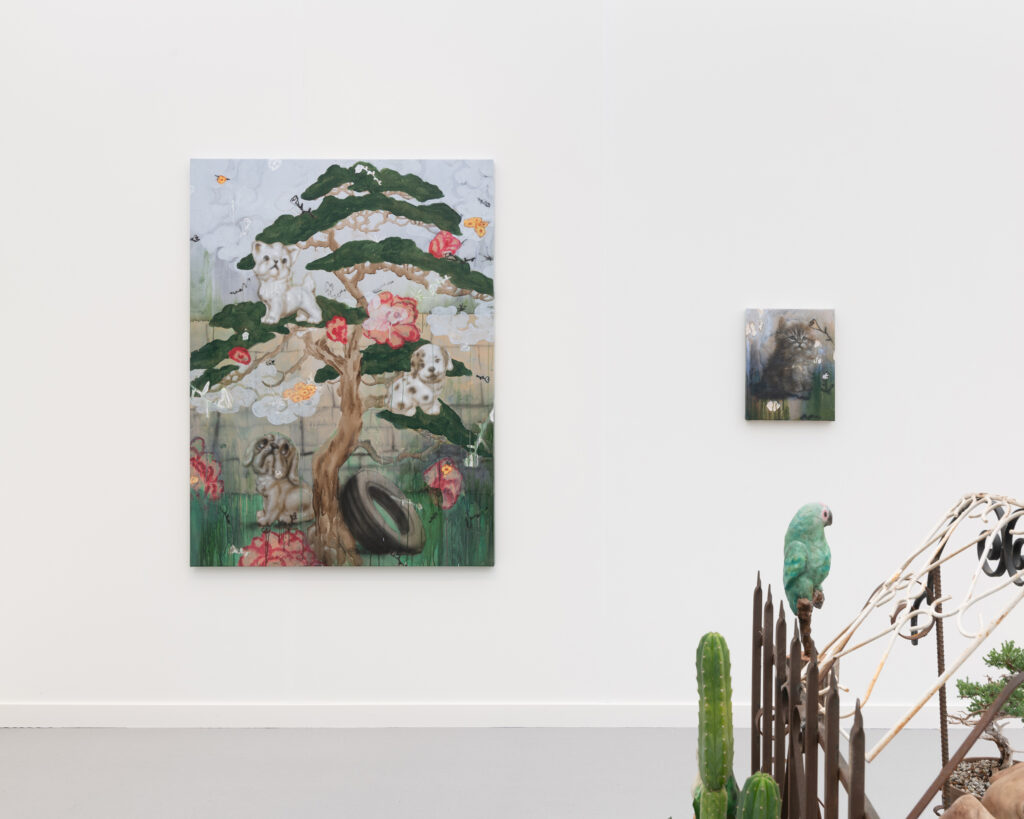
So within those interests is the motif of animals. and I feel like that’s obviously one of the first things that drew me to your work, which are your paintings of dogs and, more specifically, pit bulls. But we also see these caricatures of animals with big sparkly puppy dog eyes, so in your work, animals seem to transcend mere representation, taking on symbolic roles. I think it’s safe to say. can you delve into how your personal connection to animals intersects with your exploration of cultural symbols and what significance these creatures hold in the broader context?
I mean, there’s always like the historical context to a human’s relationship to animals, whether it’s like a religious thing or spiritual thing or just, you know, like progress in civilization, like the image of a horse, you know, to me is a really timeless kind of thing. So, I’ve always been a big animal lover, and that’s really what it comes down to. One of the first things I ever drew was probably an animal, you know. Sometimes, I assign an animal as the placeholder for my grandmother or whatever.
Dogs, in particular, came into my work after the death of my father and my cousin. I lost my Dad and my closest family member within a short period of each other, and it was my way of processing their death, I guess. My cousin had a giant pit bull; that was the first dog painting I did and also when I started using animals symbolically. Dogs have been linked to or associated with the passage to the afterlife in many different cultures throughout time. Egyptian, Greek, and Mesoamerican cultures link dogs to the afterlife or guardians of the deceased, and that really resonates with me as an animal lover.
And, like, the cutesy stuff, I feel like that all comes from my teaching, I’ve probably drawn thousands of cute kittens, you know, with my students. at the program I work for here in the Valley. Viridian Art Academy. We teach kids how to draw and paint. Traditional techniques and stuff. And 90% of the time, what they want to draw is some, like, really cute animal, and it’s snuck into my work because I enjoy it. I kind of love it.
Not all your animals are, like, “textbook” cute.
No, not all of them. The dogs started, especially because of the pit bulls. Like they get such a bad rap, you know, and anybody who’s owned one knows it’s the opposite of that, and they’re the biggest sweethearts. I just always wanted to show them in a good light, and they’ve always been a powerful symbol in, you know, suburban, urban life. And, I guess it’s like our horse, you know.
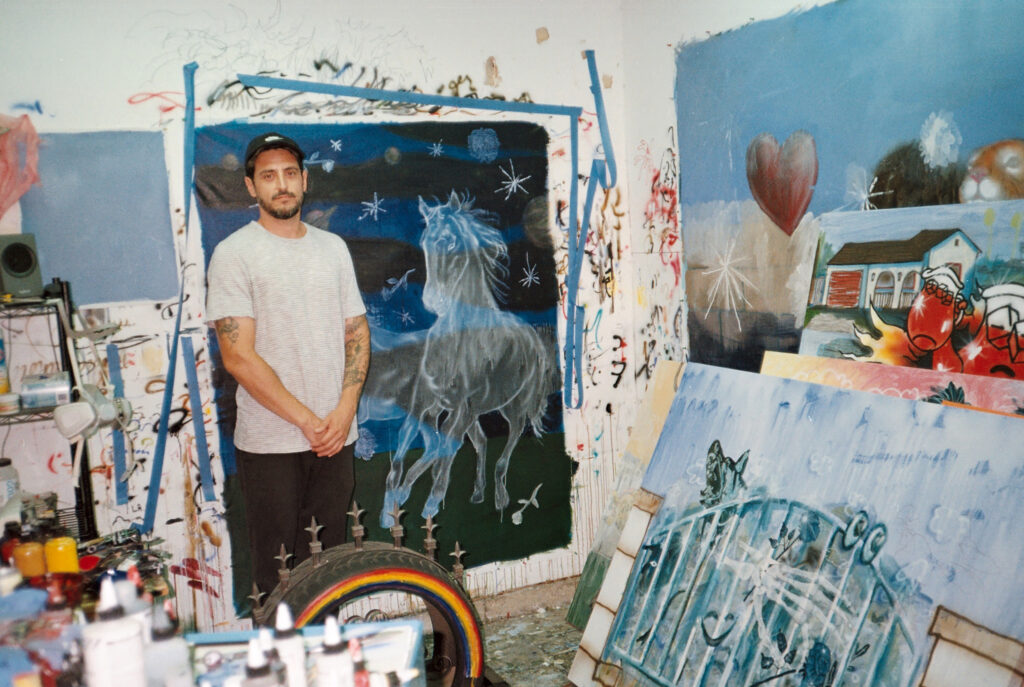
Yeah, I feel like there are two spectrums of animals in your paintings. There are the cutesy cartoony ones, and then there’s the powerful, muscular dog, muscular jaguar, and muscular horse. They’re not cute. Right. And I’m curious if there’s any sort of purpose in that contrast.
I look at a lot of traditional classical paintings, and there’s a symbol with these types of animals. It’s like a symbol to me of power to the community. And again, it’s not something I think about, but I just want to make, like when I do make a horse or something, I want it to feel powerful. I want it to feel important or like it’s present and not just like, you know, something you can’t look past or walk by without looking at it.
In your exploration of the often overlooked contributions or aspects of specifically the immigrant community, How do you navigate the fine line between memorializing their stories? And avoiding the risk of romanticizing or stereotyping their experiences. How do you ensure authenticity in your artistic representation of your labor and impact?
You know, I didn’t want just to Google an image of a jardinero, you know, like, this is a person I talk to, His wife was from the same place my dad was from, in a rural place in Michoacan, you know, like I wanted to be the people that I had a personal relationship to, not just use a random Google image. I took hundreds of pictures in my neighborhood when I was walking around and of every single person I saw that was working. I tried to make a conversation too, and sometimes I didn’t even take their picture, you know, I just wanted to see what was up and see what happened. I only photographed or used references of the people that I had a relationship with as well, I wasn’t trying to exploit them or anything, you know? And actually, the horse painting that was in the booth, the guy, the gardener that I also painted a portrait of in the booth, when I told him I was painting his picture, he’s like, “Oh, can you paint me riding my horse?” But I had already started the painting, so I was like, no, but I’ll paint you a horse, and it’ll be in the booth. So, you know, I’m not like doing this, out of nothing, these are people I know. And I took consideration into his life.
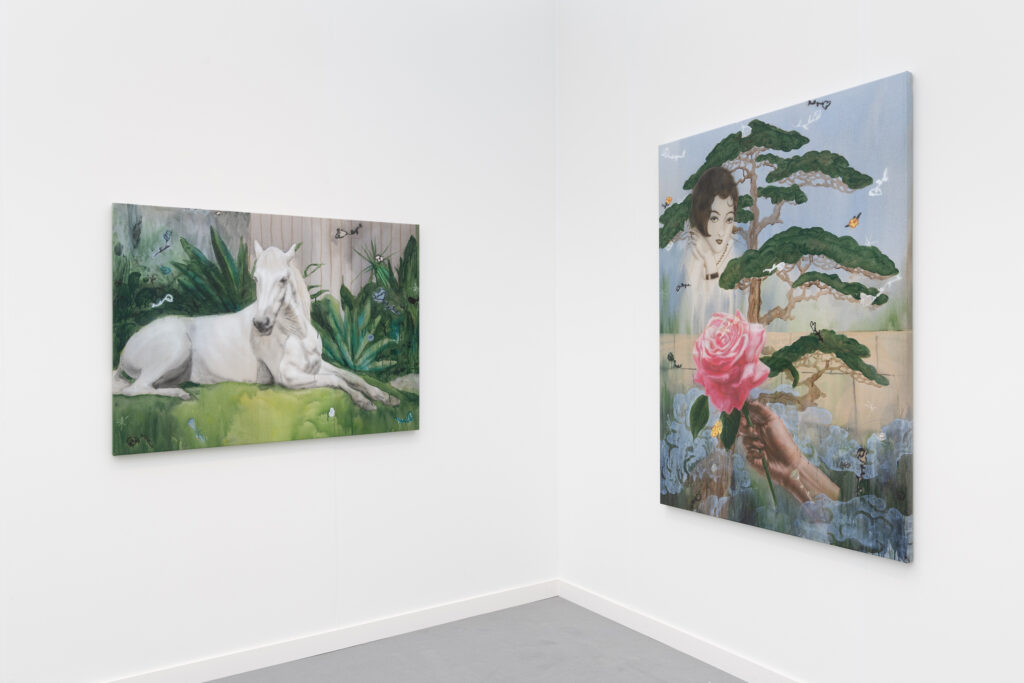
Artists
Interview & Polaroid Photos
Gallery Images
Courtesy of the gallery
Web Layout
